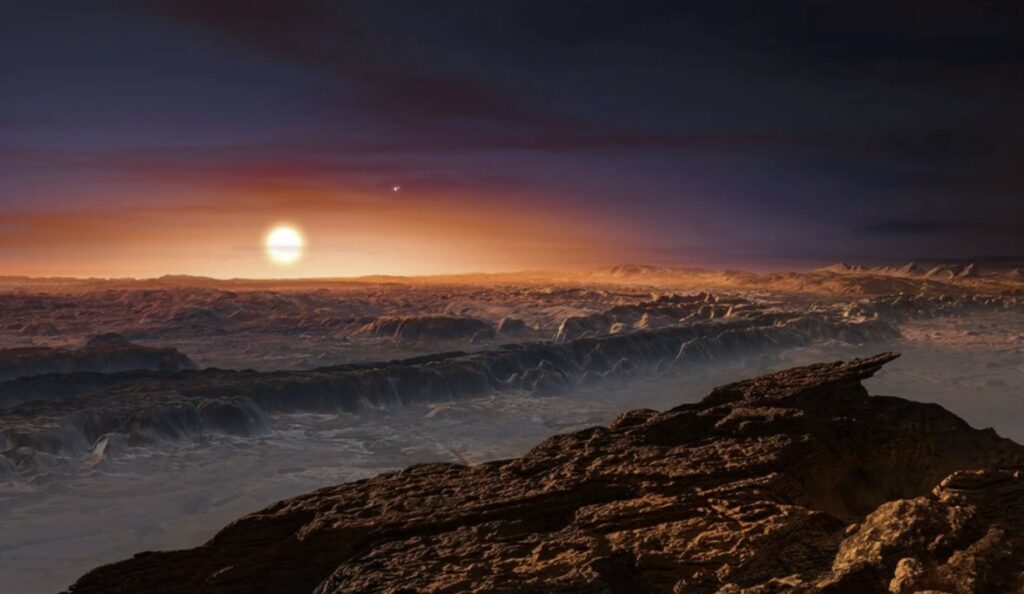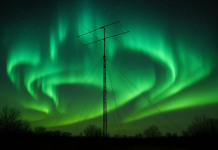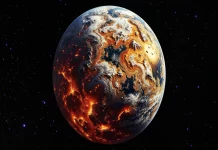
Planets that contain liquid water, the key ingredient for life as we know it, may be 100 times more common than previously assumed, according to results that were presented at a major geochemistry conference on Monday.
Life on Earth emerged in the oceans that cover most of our planet’s surface, but scientists have now demonstrated that hidden subsurface bodies of water may easily form on worlds that orbit red dwarfs, which are stars that are much smaller than the Sun. The discovery has big implications in the search for alien life because red dwarfs, also known as M dwarfs, are the most abundant class of stars and are known to frequently host rocky Earth-like planets.
Water is so fundamental to life on Earth that scientists consider it to be the most valuable compound to look for in the hunt for aliens on other worlds. While Earth is the only planet in our own solar system that currently hosts watery oceans on its surface, some of our neighboring worlds host subsurface oceans beneath their icy shells, including Jupiter’s moon Europa and Saturn’s moon Enceladus.
Lujendra Ojha, a planetary scientist at Rutgers University, has now presented evidence that geothermal heat within many cold “exo-Earths,” meaning Earth-like planets in other star systems, at the Goldschmidt Conference in Lyon, France. These subglacial oceans in red dwarf systems “might resemble the subsurface conditions found on Europa” and “may provide habitable conditions for an extended period,” according to a study led by Ojha that was published in Nature late last year.
“I was pleasantly surprised,” said Ojha in a call with Motherboard, referring to his team’s results. He added that the “TL;DR” of the research is that “if there’s ice [on a planet], it’s more likely to have melted and created liquid water than the other way around.”
The study was initially inspired by the so-called “faint young Sun paradox,” a longstanding problem in astrophysics that describes the puzzling evidence that water existed on planets like Mars and Earth some four billion years ago, even though our Sun was about 30 percent fainter in this ancient era. Scientists have suggested that geothermal activity generated by the decay of radioactive elements may have provided a heat source that contributed to what’s known as “basal melting” of ice into water, in the absence of strong solar radiation.
“Most Earth-like exoplanets that we have found today orbit around M dwarfs,” Ojha explained. “Given that basal melting was something that likely happened and, depending on who you talk to, could have been one of the main ways of generating liquid water on our solar system’s planets billions of years ago, we wanted to ascertain what would be required for basal melting, and if this could happen on other planetary bodies.”
With that aim in mind, the researchers ran sophisticated models of exoplanets that are based on real worlds that have been spotted by telescopes, including Proxima Centauri B, TRAPPIST-1 e, and Kepler 442 b. The team specifically focused on the dynamics of various ice sheets as a way to constrain the odds that subglacial oceans could melt out as a result of geothermal energy on extraterrestrial worlds.
The results revealed that even modest flows of geothermal heat could thaw out bodies of water under the ice shells of distant exoplanets, indicating that these hidden oceans are likely abundant in red dwarf systems across the Milky Way.
Indeed, the team’s study, along with a subsequent commentary that appeared in Nature a few months later, suggest that there may be 100 times as many “potentially habitable worlds” in our galaxy than originally presumed. In other words, there may be an average of one planet with liquid water for every star system in the Milky Way, which represents a vast expansion of planetary habitability.
What’s more, the billion-year half-lives of radioactive elements could provide a long-term stable heat source to these subterranean seas, raising the odds that life could emerge and flourish in them. That last point is particularly important for scientists who specifically study the habitability of red dwarf systems, which is a topic of heated arguments.
Red dwarfs may be smaller and dimmer than the Sun, but they are known to produce intense light and eruptive flares that could prevent life from taking hold on the surface of their planets. However, life that emerged in subglacial oceans on these worlds would be protected from these damaging surface effects by a layer of ice.
“The habitability of M dwarfs is a very interesting and a very debated topic,” Ojha said. “What’s interesting, and I think noteworthy, about the idea of basal melting and subsurface oceans is that the star could be the biggest bully in that galaxy and it doesn’t matter. Underneath a couple of meters of ice, if there is water and if there is some sort of primordial life, most of the X-rays, or the solar flares that maybe sporadic, are not going to notably affect these deep biospheres compared to if the life or biosphere were on the surface.”
“Deep, deep within the ice, it provides a refuge, so I think it’s interesting that basal melting not only provides an alternative way of creating this habitable environment, but it’s very much more protected than if there was any like the surface,” he added.
Of course, nobody actually knows if cold exo-Earths host life, but there are a wide variety of new missions and techniques that might shed more light on this tantalizing mystery in the coming years and decades. For instance, NASA plans to launch its Europa Clipper spacecraft to closely observe Jupiter’s icy ocean moon in 2024, and concept missions have also been proposed to search for life directly at Enceladus.
These efforts could reveal the properties of our local ocean worlds, including whether they host life, which could inform the search for aliens in similar environments across the galaxy. In addition, it’s possible that new generations of telescopes might be able to spot geysers of water bursting from planets in other systems.
“One of the most important things that we will learn from those missions is the chemistry of the water, what the water is like, how much heat do you need for this water to be sustainable to life, and potentially looking for astrobiological signals,” Ojha said. “I think that would help us in understanding the habitability of ocean worlds.”
“One potential way for us to look at the possibility of basal melting on these other bodies is to potentially see signatures of plumes of water coming out similar to what we see in Enceladus and Europa, but we will need a slightly better adaptive optics for our telescope, so that’s also slightly in the future,” he concluded. [Nature, VICE]
Guys, it’s time to wake up!
If a few more people choose to support my work, I could expose more lies, root out more corruption, and call out more hypocrites. So, if you can afford it, please support my endeavor by either using PAYPAL or the DonorBox below (PAYPAL & Credit Cards / Debit Cards accepted)…
You should join my newsletter to get a compilation of different breaking news, pictures and videos on a daily manner…
Thank you,
Manuel












